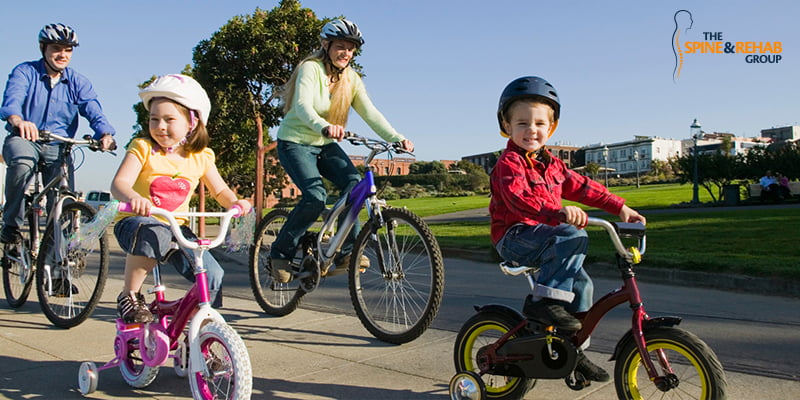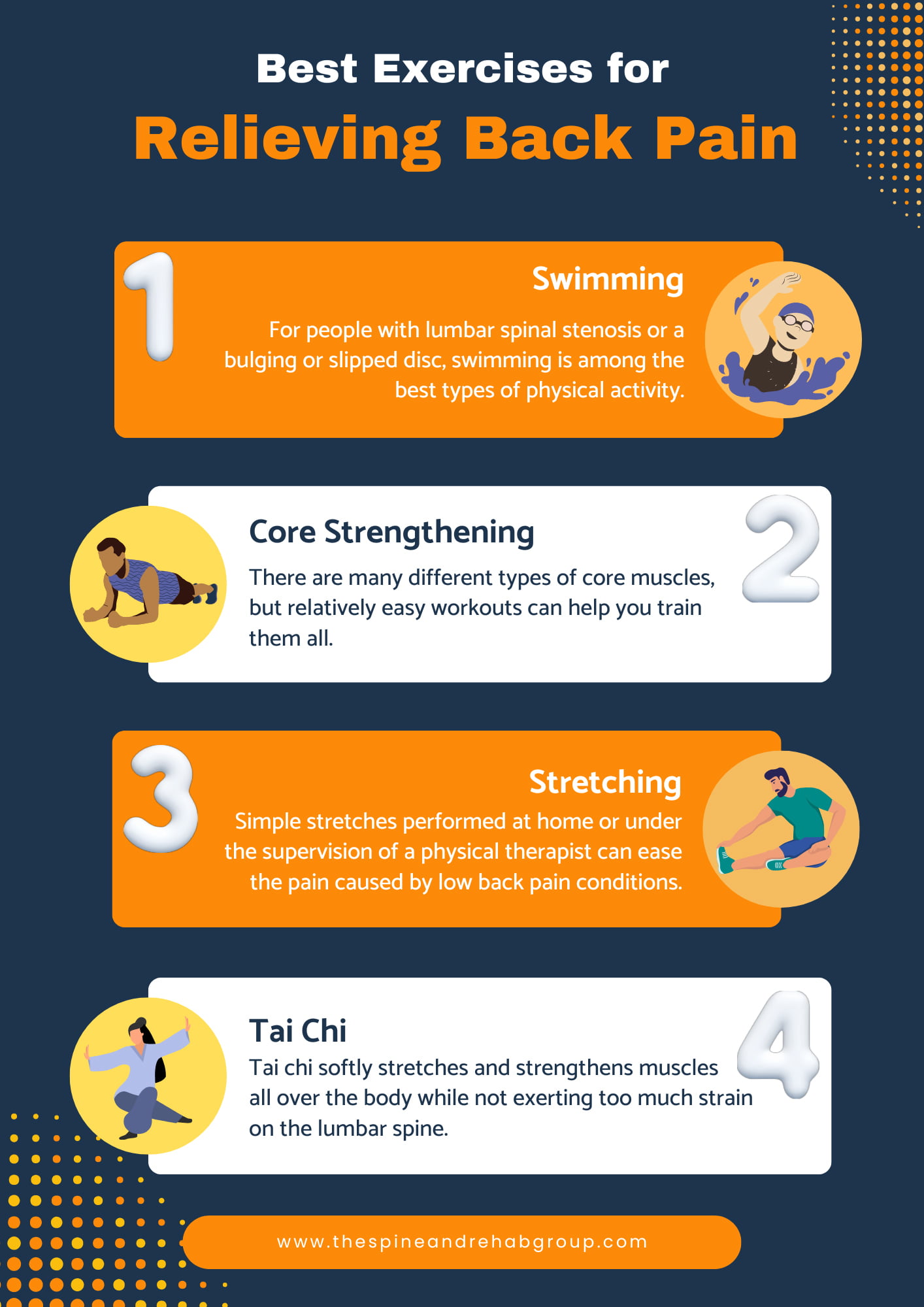 OUR LOCATIONS
Call to book 201.523.9590
OUR LOCATIONS
Call to book 201.523.9590
 OUR LOCATIONS
Call to book 201.523.9590
OUR LOCATIONS
Call to book 201.523.9590

Back discomfort is a common occurrence throughout life. No matter your gender or whether you stand or sit all day at work, you may encounter either transient or chronic back pain that interferes with your regular activities. Most patients take painkillers and use hot and cold compresses to treat their symptoms. Although these approaches can be effective, they aren’t the only options available. One of the best strategies to lessen pain is through exercise.
So is cycling beneficial for disc bulges? Any exercise that requires forward tilting should be avoided. Long rides and poor posture can make a bulging disc worse and cause additional damage. With a bulging disc, swimming, core training, tai chi, or even stretching are preferable and safer forms of exercise. These exercises are a safer option for lower body exercises because they don’t place too much strain on the spinal column.
Exercises that include bending forward or crouching help ease back and leg pain whenever the spinal canal has become compressed and narrowed. However, in cases of spinal instability and vertebral slippage, such as a bulging or herniated disc, forward flexion can result in back and leg pain. Before beginning a bike riding exercise, it’s crucial to recognize and be aware of your condition that might be causing the specific back pain.
If you have ever experienced back problems, it’s highly essential to consult your doctor before beginning any fitness program to be sure you’re healthy enough to do so. Most people, including those who have mild back pain, should be able to begin bike activity once they’ve been cleared by their doctor.
Before beginning biking as a workout, anyone with more chronic or severe pain in their back should visit a spine specialist. A physical examination and sometimes even x-rays or more advanced imaging tests like a CT scan or an MRI are frequently involved. The symptoms of a spine condition may get worse or better depending on which exercises you perform.
If you want to avoid experiencing or aggravating back pain, you should consider your options before hitting the trails or hopping on your bike, regardless of whether bicycling is a new hobby or an activity you’d want to pursue. Here are a few reasons why biking can affect your back:
Depending on how severe your injury is and how much pain you’re in, you might be able to ride a bike. When your doctor gives you the all-clear to go bicycling, warm up your muscles before riding by performing some therapeutic activities.
Use standing leg presses to strengthen the buttocks and the leg muscles while also allowing both hip joints to move through a healthy range of motion. Postural awareness, therapeutic yoga postures, and therapeutic exercises are meant to be combined to assist relieve discomfort and keep you active. Utilize a light set of weights or do 3 sets of 8 repetitions with no weight.
Add resistance training to your routine to assist your hip flexors and leg muscles get stronger and more stable so you can walk and ride a bike. If possible, use the machines for the seated double hip adductor and double hip abductor to strengthen your hip flexor.
Remember to use a very lightweight for 3 sets of 8 repetitions. You exercise the adductor muscles in the inner thighs and the gluteus medius in the outer hips by doing this. Both aid in sacral stability for a steady posture when walking and comfort when seated on a bike seat.
Numerous yoga poses can aid with pain management and poor posture correction to stop additional injuries. Any spinal complications can be immediately detected when in tadasana, also known as mountain position. When you overarch your low back, you get an inward curve of the lumbar spine. Standing with your feet hip-width apart and your knees slightly bent will help you find tadasana.
The tadasana pose strengthens a tall posture to ease compression in the lower back. If you can keep your pelvis in a healthy position while biking, you may prevent yourself from experiencing any lower back pain or discomfort.
Along with the essentials of outdoor cycling safety, like using a helmet and highly visible clothing, maintaining your bike, installing reflectors, and adding lighting, you should create a training schedule in advance. To prevent spinal disc bulge reactions and reduce the risk of injuries, a training plan should be used with any exercise:
The first step towards treating and preventing chronic back pain involves exercise. You can explore various workout alternatives to find back pain relief once you and your doctor have discussed the source of your back pain. The following are some exercises that can provide relief from severe pain brought on by a bulging or herniated disc.
For people with lumbar spinal stenosis or a bulging or slipped disc, swimming is among the best types of physical activity. The low-impact environment of the water is ideal for enhancing muscle strength, flexibility, and endurance. Stretching and building up the muscles that allow the spine to flex forward and backward can be accomplished through swimming.
You won’t need to worry about straining your spine as you concentrate on working those muscles. The spine will stretch as you float. As you exercise your arms and legs, you’re strengthening both those muscles and your core.
Your spine will feel less strain as a result of improved core strength because your body will be better equipped to support your weight. Another step toward reducing spinal canal pressure is weight loss, which is another way that swimming can be successful.
The stabilization, flexibility, and range of motion of the body are influenced by the core muscles. Other muscles will step in to fill in the gaps created by weak core muscles. Your back may occasionally contain those muscles. There are many different types of core muscles, but relatively easy workouts can help you train them all.
Planks, for instance, are a great core exercise. There’s no particular training or equipment required. Position your body in a push-up stance with a long, straight back, resting either on your wrists or forearms. Maintain that posture. Try side planks as well. Although the idea is the same, you position your body to one side. Your weight is supported by one forearm as you raise and lower your body.
Simple stretches performed at home or under the supervision of a physical therapist can ease the pain caused by spinal disc herniation, lumbar spinal stenosis, and other low back pain conditions. Stretches like knee-to-chest repetitions, for instance, might ease the pain. Take both knees in your hands, draw them to your chest, and keep them there as you lay flat on your back on the floor.
Another option is to keep both legs straight and on the ground while holding one knee to your chest at a time. Additionally, you could attempt a few easy exercises for your upper back and neck, which could aid with proper spinal alignment. For instance, try performing shoulder rolls or chin tucks repeatedly.
One of the ideal activities for a bulging or slipped disc in the lower back and other back pain disorders is tai chi, a Chinese tradition. According to a study, about 90% of participants who performed tai chi for back pain saw some improvement. The movements are deliberate and slow, despite the fact that this practice is officially a martial art.
This type of training entails fluidly transitioning through a variety of poses while concentrating on your mental concentration and breathing. Tai chi softly stretches and strengthens muscles all over the body while not exerting too much strain on the lumbar spine.

Exercise needs perseverance and dedication, but sweat and work can be worthwhile. There are many advantages to implementing a fitness routine as your primary back pain management strategy for a spinal disc bulge or disc herniation, among them are:
When it comes to treating a herniated or bulging disc, pinched nerve, spinal stenosis, and other conditions that cause back pain, exercise can be quite effective. Your body needs time to adapt to your exercise regimen, so you must be patient with it. It’s time to set up a consultation if you’re exercising regularly but aren’t experiencing any improvements. Consult a spine specialist to determine the cause, learn about your choices for treatment, and start the treatment process.
At The Spine And Rehab Group, we can assist in diagnosing, treating, and effectively managing your back pain with our customized treatment plans and highly-skilled medical staff. We take great pleasure in being one of the leading clinics for spinal health in New York City because of our dedication to providing cutting-edge and excellent medical care. Contact us today to learn more about our services.



